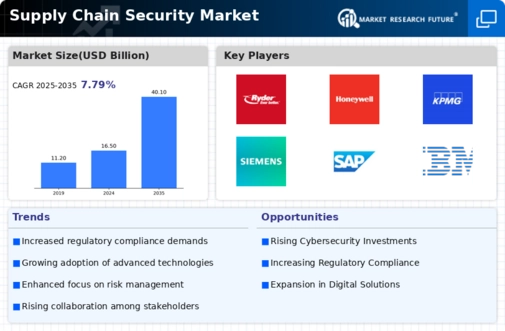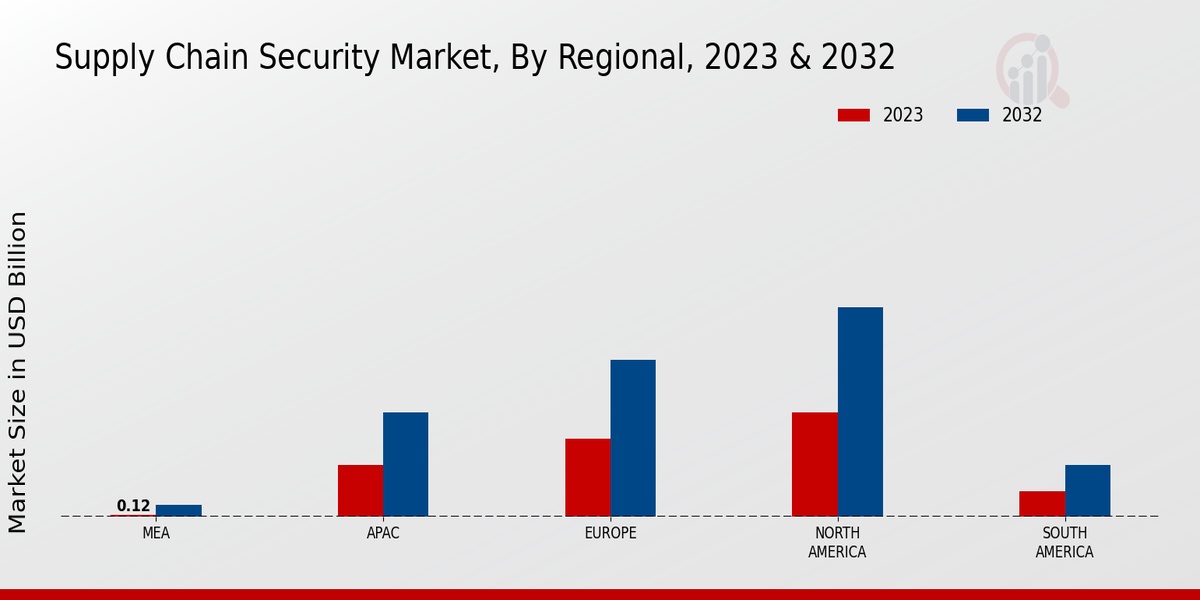Market Growth Projections
The Global Supply Chain Security Market Industry is poised for substantial growth, with projections indicating a market value of 40.1 USD Billion by 2035. This growth is underpinned by various factors, including increasing cybersecurity threats, regulatory compliance requirements, and technological advancements. The anticipated compound annual growth rate of 8.4% from 2025 to 2035 reflects the industry's adaptability to emerging challenges and opportunities. Companies are likely to invest in innovative security solutions to safeguard their supply chains, ensuring resilience in an increasingly complex global landscape.
Globalization of Supply Chains
The globalization of supply chains has introduced complexities that necessitate robust security measures. As companies expand their operations across borders, they face diverse risks, including geopolitical tensions and varying regulatory environments. This complexity drives the demand for comprehensive supply chain security solutions. The Global Supply Chain Security Market Industry is adapting to these challenges by offering tailored solutions that address specific regional risks. The anticipated compound annual growth rate of 8.4% from 2025 to 2035 underscores the industry's response to the evolving landscape of global supply chains, as organizations seek to mitigate risks associated with international operations.
Increasing Cybersecurity Threats
The Global Supply Chain Security Market Industry is experiencing heightened demand due to the escalating threats posed by cyberattacks. As organizations increasingly rely on digital platforms for their supply chain operations, vulnerabilities have emerged, leading to significant financial losses. For instance, the average cost of a data breach in 2024 is estimated to be around 4.24 million USD. This has prompted businesses to invest in advanced cybersecurity measures, thereby driving the market's growth. The industry's value is projected to reach 16.5 USD Billion in 2024, reflecting the urgency to secure supply chains against cyber threats.
Regulatory Compliance Requirements
Regulatory frameworks are becoming more stringent, compelling organizations to enhance their supply chain security protocols. Governments worldwide are implementing regulations that mandate compliance with security standards, such as the NIST Cybersecurity Framework. This trend is particularly evident in sectors like pharmaceuticals and food safety, where compliance is critical. The Global Supply Chain Security Market Industry is likely to benefit from these regulations, as companies invest in solutions to meet compliance requirements. As a result, the market is expected to grow significantly, with projections indicating a value of 40.1 USD Billion by 2035, driven by the need for adherence to these regulations.
Rising Consumer Awareness and Expectations
Consumer awareness regarding supply chain practices is on the rise, leading to increased expectations for transparency and ethical sourcing. As consumers become more informed about the implications of their purchases, companies are compelled to adopt secure and responsible supply chain practices. This shift is influencing the Global Supply Chain Security Market Industry, as organizations invest in security measures that align with consumer values. The demand for transparency and ethical practices is likely to drive market growth, with projections indicating a significant increase in value by 2035, as businesses strive to meet evolving consumer expectations.
Technological Advancements in Security Solutions
Technological innovations are reshaping the landscape of supply chain security, leading to the development of sophisticated solutions. Technologies such as blockchain, artificial intelligence, and the Internet of Things are being integrated into supply chain operations to enhance security and transparency. For example, blockchain technology is being utilized to create immutable records of transactions, thereby reducing fraud risks. The Global Supply Chain Security Market Industry is witnessing a surge in investments in these technologies, as organizations recognize their potential to streamline operations and bolster security. This trend is expected to contribute to the market's growth trajectory, with an estimated value of 16.5 USD Billion in 2024.











